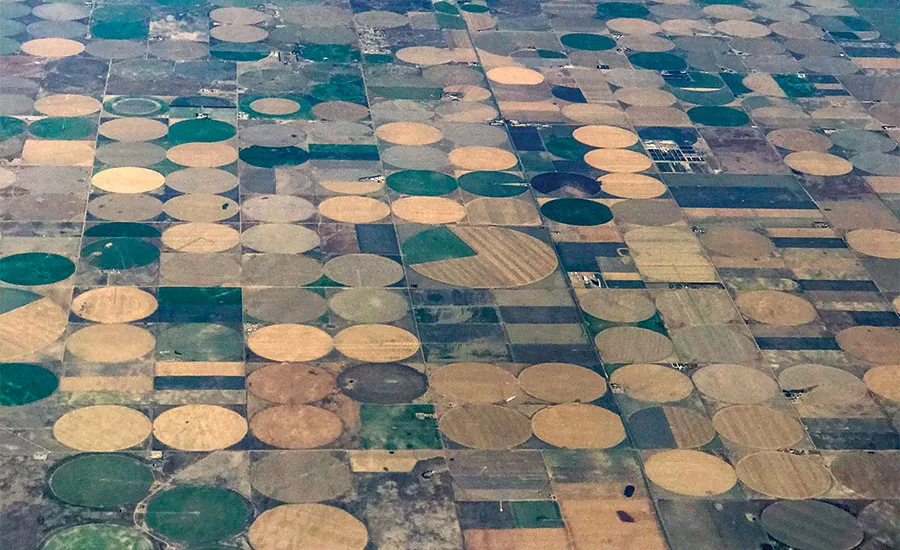For Drillers, Some Thoughts on Formation Pressure

The Ogallala Aquifer has helped farmers in the Great Plains for generations, but declining formation pressure means recharge has not kept up with pumping.
I am sure everyone has noticed that water wells have vastly different water levels, both while static and pumping. These differences are due to formation pressure.
Sometimes the pressure will be high enough that the well flows at surface. Usually this can be traced to the area of recharge. For instance, the Ogallala Aquifer, which spans the western plains from north Texas to the Dakotas, receives most of its recharge from snow melt on the east side of the Rockies, which are a much higher elevation. When this aquifer was discovered, wells in many places flowed due to high formation pressure. This bonanza irrigated crops on the Great Plains for over 100 years. After long and sustained use, water levels dropped so much that pumps had to be set deeper, and wells deepened, to reach the water. This is due to declining formation pressure.
The easiest way to think about it? An aquifer is like a savings account. You can’t take out more than you put in without eventually running out. Recharge is like adding money and pumping is like withdrawing. If the account is big enough, you can withdraw a lot for a long time, but the outcome will be the same. In the West, water levels and formation pressure are driven primarily by elevation change.
In the southeastern United States, we have an aquifer called the Ocala Lime. It runs, generally, along the East Coast from South Carolina through Georgia and into central Florida. Even though the land is nearly flat and near sea level, the aquifer is shaped like a huge bowl. It comes nearly to the surface at the northern and southern ends. These are the major recharge zones. As the water flows to the center of the bowl, it gains pressure — and many wells in south Georgia flow because of high formation pressure.
In 1905, the United States Geological Survey (USGS) drilled an exploration well in Brunswick, Georgia. The well had over a 60-foot head. At the time, many people didn’t even have pumps because the water pressure was high enough to easily flow to the second story. Eventually, with population growth and industrial use, the formation pressure dropped to the point that it needs to be pumped. I drilled a well in a pulp mill, about one mile away from the exploration well, and the static level was about 20 feet below surface. This is a net loss of 80 feet of head.
Think of the savings account. There is enough for a long time yet, but a long time is not forever. As we use more and more water, the formation pressure drops, and pumps have to be set deeper and wells drilled deeper to keep up.
In the Southeast, this problem is not one of simply running out of water. The fresh water in the Ocala Lime sits on a vast pool of saltwater. If you pump enough, the well will eventually salt out and be unusable for irrigation or domestic consumption. The obvious cure is to curtail use to a manageable amount — namely, equal to the natural recharge. But, since the decline is so gradual, people think it will last forever. It won’t.
People are starting to become aware of better conservation practices and that’s good. Years ago, it was common to see flowing wells just piped to the ditch to make pump installation easier. They flowed and wasted formation pressure for years. Fortunately, we don’t see much of that any more.
On the other side of the coin is very low formation pressure. Mud drillers hate this, because it often leads to lost circulation and very difficult drilling. The causes might include the formation having little natural recharge or a situation where the water is draining down to a lower aquifer. The water is there, but it can be difficult to develop and produce.
A well in such a formation is typically drilled with mud that is as light as possible, yet still having a high viscosity and good wall cake building properties. The mud companies love this. They are going to sell you lots of product! Air drillers are not usually troubled by this, but the formation must have enough strength to hold the hole open until you get the casing in.
In some cases, with a flowing well, it is necessary to stop the flow to work on the well. This might be to replace the pump or install a new wellhead. In the oilfield, this is usually done with a weight material such as barite. This will kill most any pressure, but the water well industry does not much use it because it can plug the formation and make development difficult. Usually, water wells that flow don’t have too much formation pressure and operators can easily kill them with saltwater. To do this, mix a saltwater pill and displace it into the well with a tremie line. Since the saltwater is heavier, it will usually stop the flow long enough to do your work. Also, since it is dissolved, with no solids it won’t plug the formation, and can be developed out easily. When setting a pump in this situation, just run the pump to open discharge until the salt pill has been pumped off, and you will have your flow back.
Having an understanding of the reasons for, and the ways to deal with, formation pressure is a necessary part of a good driller’s toolbox.
For more Wayne Nash columns, visit www.thedriller.com/wayne.
Looking for a reprint of this article?
From high-res PDFs to custom plaques, order your copy today!


